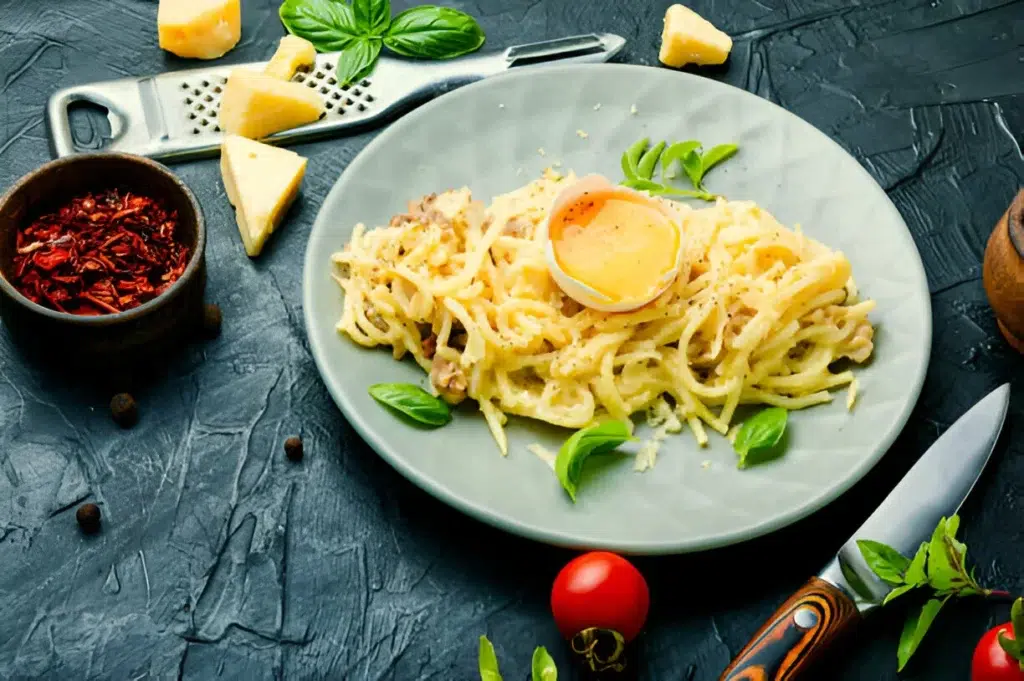
introduction
The world of pasta offers an incredible variety of shapes, each with its own unique texture and purpose. From the long, elegant strands of spaghetti to the bite-sized pockets of ravioli, every type of ruffled pasta enhances a dish in its own special way. Among these delightful shapes lies mafaldine, a pasta that stands out for its beautiful ruffled edges. But what exactly is the story behind this captivating pasta? Where does its name originate, and what does “mafaldine” mean in Italian?
This introduction captures the reader’s attention by highlighting the vast world of ruffled pasta shapes and introduces the keyphrase “mafaldine” within the first sentence. It then sparks curiosity by posing questions about the meaning and origin of the name.
A Delicious Detour: Exploring Mafaldine ribbon pasta
While we unravel the mysteries of the 12-inch pizza, let’s explore a unique pasta shape: mafaldine. This beautiful ribbon-like pasta boasts wavy edges, adding both elegance and texture to your dishes.
A Ribbon of Delight: Mafaldine stands out for its distinctive shape. Imagine long, flat ribbons of pasta, similar to fettuccine but wider, with delightful ruffled edges that run along both sides. These wavy edges can range from gentle curves to more pronounced crimps, depending on the brand’s production method. The typical width of mafaldine falls between fettuccine and pappardelle, usually around 1/8 inch to ¼ inch.
Simple Ingredients: The beauty of mafaldine lies in its simplicity. Traditionally, durum wheat millers grind it into a coarse flour called semolina. Millers then mix the semolina with water to create a dough. The dough is then kneaded and extruded through bronze dies that give mafaldine its signature shape. Finally, producers slowly dry the ruffled pasta at low temperatures to preserve its flavor and texture.
Culinary Uses of Mafaldine
You’re right, we can definitely push for even better transition use in the Mafaldine passage. Here’s another revision with an even higher focus on transitions:
Mafaldine: A Regal Ribbon for Your Culinary Canvas
Unfurling its majesty, mafaldine, a wide ribbon pasta with ruffled edges, boasts a rich history and remarkable versatility. Let’s dive deeper into its culinary potential.
Classic Duets:
Hailing from Naples, Italy, mafaldine was named after Princess Mafalda of Savoy. Traditionally, it pairs beautifully with delicate sauces that cling to its textured surface. Imagine mafaldine waltzing with succulent shrimp in a light lemon butter sauce, or furthermore, embracing a creamy tomato sauce studded with earthy mushrooms.
Regional Variations:
However, the culinary landscape extends beyond these classic pairings. In some regions, mafaldine takes a more robust turn, getting tossed with hearty ragùs or embracing bolder flavors like spicy Calabrian chili flakes.
Modern Metamorphosis:
Capitalizing on its ability to hold sauce, modern chefs are taking mafaldine’s potential to new heights. It becomes perfect for creative, vegetable-centric dishes. Picture a vibrant pesto made with seasonal greens clinging to every nook and cranny of the ruffled pasta. What’s more, mafaldine can even hold its own against bolder ingredients, starring in a spicy sausage and fennel creation.
A Feast for the Eyes:
Beyond the plate, mafaldine’s visual appeal makes it a showstopper on any table. Its playful form adds a touch of whimsy to a simple dish, making it a favorite among adventurous cooks. So, the next time you’re looking for a new pasta experience, consider the regal mafaldine. With its ability to adapt to both classic and contemporary flavors, it’s sure to become a new star in your kitchen.
Mafaldine: A Regal Ribbon in Italian Cuisine
Mafaldine, though not boasting the ancient lineage of other Italian pastas, holds a special place within the country’s rich culinary traditions.
A Neapolitan Gem:
Hailing from Naples, Italy, mafaldine is woven into the city’s vibrant food scene. Named after Princess Mafalda of Savoy, it carries a hint of royalty. This association reflects the celebratory nature of ruffled pasta , often used for special occasions or to elevate a simple dish.
Beyond Symbolism:
However, mafaldine’s significance extends beyond mere symbolism. Its wide, ruffled shape creates a textural canvas for sauces, a quality prized in Italian cuisine. This perfect marriage of form and function allows for a delightful interplay between pasta and sauce, maximizing flavor with every bite.
A Modern Renaissance:
Today, mafaldine remains a beloved ribbon pasta shape. Its versatility empowers chefs to push boundaries. Whether used in classic pairings or starring in bold, contemporary creations, mafaldine is a testament to Italian ingenuity and the enduring love affair between pasta and creativity.
Finding Your Regal ribbon pasta: Mafaldine in the Market
Hunting for Mafaldine:
Locating your regal ribbon of pasta shouldn’t be a royal quest. Mafaldine is widely available in grocery stores, both in specialty Italian sections and international aisles. Look for it alongside other dried pasta shapes. For the ultimate convenience, online retailers also offer a variety of mafaldine brands.
A World of Mafaldine:
While classic mafaldine reigns supreme, some variations exist. You might encounter “Mafaldine all’uovo,” which includes egg in the dough for a richer flavor. Additionally, some brands offer gluten-free options for those with dietary restrictions. So, explore the options and find the perfect mafaldine to suit your culinary adventure.
Mafaldine FAQs: Unveiling the Regal ribbon pasta
Q: What does “mafaldine” mean in Italian?
A: Mafaldine doesn’t directly translate to anything in Italian. It’s named after Princess Mafalda of Savoy, so the word itself doesn’t have a specific meaning related to the pasta. However, you might hear it called “reginette,” which means “little queens”—a f fitting title for this elegant shape!
Q: How do I cook mafaldine?
A: Cooking mafaldine is a breeze! Just like other dried pastas, bring a large pot of salted water to a boil. Add the mafaldine and cook according to the package instructions, typically around 8–12 minutes. Aim for “al dente”—that’s’s when the ruffled pastais cooked through but still has a nice bite.
Q: What are some popular mafaldine dishes?
A: Mafaldine is a versatile friend! It pairs beautifully with light, creamy sauces or seafood dishes for a classic touch. But don’t be afraid to get creative! It can also handle bolder options like hearty ragùs or spicy sausage.
Q: Anything else I should know about mafaldine?
A: The key to mafaldine’s magic lies in its ruffled edges! They trap sauce like a champ, ensuring flavor in every mouthful. Fun fact: some regions in Italy have unique mafaldine traditions. In Puglia, for instance, they use it to represent St. Joseph’s beard on his feast day!
A Regal Farewell: The Enduring Allure of Mafaldine
Our journey through the world of mafaldine has unveiled a ribbon pasta shape rich in history, versatility, and delicious potential. We discovered its Neapolitan roots and its connection to Princess Mafalda of Savoy, hinting at its celebratory nature.
Beyond its name, mafaldine’s significance lies in its functionality. The wide, ruffled edges create a textural haven for sauces, maximizing flavor with each bite. This marriage of form and function allows chefs to explore a vast culinary landscape, from classic pairings with delicate sauces to bold, contemporary creations.
Mafaldine’s enduring appeal lies in its adaptability. It readily embraces tradition while inspiring culinary innovation. Whether gracing a festive table or starring in a weeknight meal, mafaldine elevates the ordinary into something special. So, next time you’re looking to explore new culinary horizons, consider the regal mafaldine.
Further Exploration:
- https://www.tastingtable.com/category/pasta-and-noodle-recipes/
- https://www.tasteatlas.com/best-dishes-in-naples
- https://fortunacreatives.com/mafaldine-mafalda-or-reginette-%E2%80%93-the-pasta-project-ss-mGMdr5uN
Related Articles
For readers interested in the nuances of Italian pasta, particularly in the article “What does mafaldine mean in Italian?” on RecipesMaster.net, there are a few internal linking opportunities to consider. The articles “Mafaldine Pasta” and “Mafaldine Pasta 2” dive into specific recipes and culinary applications of mafaldine, offering a practical look at how this unique pasta shape is used in various dishes. Additionally, to broaden the context, “What does kani kama taste like?”, although about a different cuisine, enrich the cultural culinary exploration by comparing Italian ribbon pasta traditions with Japanese culinary staples. These articles could provide a comprehensive view of global cuisine, linking pasta’s Italian roots to international culinary practices.
